I always find that animals and plants that live underwatertend to look pretty flat, boring or just plain uncomfortable out of it. Nowhere is this more obvious than at the seaside ‘rock pooling’. So instead of turning over stone after stone you can make a naturalist’s version of a dentist’s mirror to allow you to look under overhanging rocks and in crevices. I call this quite simply a mirror on a stick.
Handy stuff: mirror on a stick
Use this extended mirrorto bounce light into the shadows. I find it one of the best ways to find egg cases of dog whelks and other creatures that want to keep out of harm’s way.
YOU WILL NEED
> thick, but bendable wire
> travel mirror
> gaffer tape
> scissors
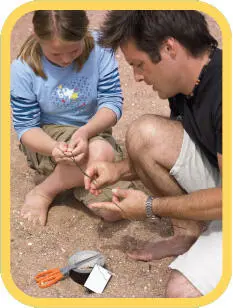
1 Take 6ocm of thick but bendable wire, fold it in half and twist.

2 Bend one end at right angles and attach to a travel shaver’s mirror with reinforced gaffer tape (from a DIY shop). Make a more solid handle by binding the other end with the gaffer tape.
3 Use the mirror to shed light on those otherwise dark and sinister cracks and crevices.
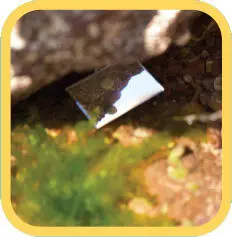
4 Bend the wire into a right angle so you can look in all those rock pools. You can even get an idea of what the world is like looking up from a crab’s point of view.
I remember going ‘shrimping’ as a kid,hunting for prawns for my supper. This involved tossing bait into the pools and coming back later to scoop up the unfortunate crustaceans into a net. But I found that some of the bait was seemingly being pulled by an invisible force across the bottom of the pools while other pieces exploded into hundreds of fragments, which would then be shunted around rapidly, resembling underwater fireworks. Other bits had simply disappeared! Very soon I was gazing into the pools trying to figure out who the thieves were. It was at that moment I was hooked, and so I became a rock pool investigator.
Many of the residents of rock pools are opportunists– they take whatever they can, whenever they can. They are the scavengers and the waste disposal units of the sea. By placing bait in the pools you are actually recreating something that happens all the time in nature.
When a creature dies anywhere in any ecosystem on the planet,there are a whole host of other creatures ready to return the goodness its body contains back into the living system, and rock pools are no exception. Animals die here, and our coasts are also the last resting place for many other creatures that die at sea and are washed up. Believe me, a body in a rock pool will not last long. But don’t just believe me, try it out for yourself.
Really it’s all about experimenting.Different baits may work better in different places and at different times, but the basic principle is the same. For best results, you need to spread the word to the rock pool community that bait has arrived, and you want the word to reach as many different creatures as quickly as possible.
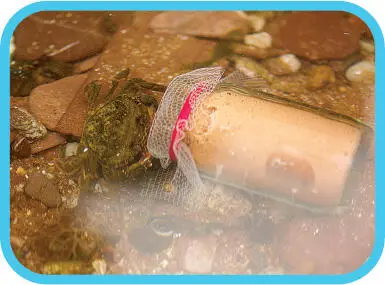
Nick’s trick
Use the smelliest bait possible and ideally one that contains an element of ‘soup’; soft stuff that will break up into tiny particles and get wafted around in the water currents.
YOU WILL NEED
> smelly bait
> piece of string
OR
> pot of fish paste
> piece of mesh or old stocking
> elastic band

1 Bring your own bait; the smellier the better as this will waft around in the water and draw in creatures from further afield. I have used everything from scraps and trimmings that my local fishmonger has given me, like nice and smelly fish heads and tails, to bacon or ham that I have removed from my own sandwiches.
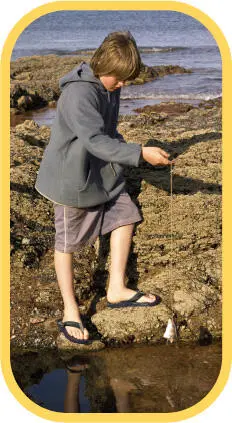
2 Attach your bait to a piece of string so you can lift the bait out of the water if a particularly greedy or boisterous crab or fish comes along. Many scavengers, such as crabs and blennies, can be very greedy and will leave the scene altogether, taking your bait with them.
3 If the idea of handling smelly dead fish bits really fills you with disgust, there is a neater little trick that also works well using a pot of fish paste. Take the lid off your pot and stir up the contents a bit. Then cover with the mesh or old stocking and secure firmly with the elastic band.
4 Pop the pot into a rock pool and that’s it! Just sit back and watch as the residents come scuttling.
Handy stuff: scavenger trap
Around areas where there is a fishing business,you may well come across large rope and wooden structures used to catch crabs and lobsters. You can borrow this idea and make your own rock pool version.
The trap is made from a container,which lets the smell of your bait escape into the water. When the creatures come searching, they find their way in via a funnel. This then acts as a one-way valve, trapping them inside. The cheapest way to do this is with an old plastic drinks bottle.

With the aid of your scavenger trap and a field guide you will soon be able to identify many different rock pool creatures.
Nick’s trick
In an area where netted dog whelks are found, try dragging your bait around on a sandy bottom and watch what happens. These scavenging snails will follow the trail, siphons up, as they pick up the smell of the bait.
YOU WILL NEED
> old plastic drinks bottle
> scissors
> bait
> gaffer tape
> string
> plastic tank
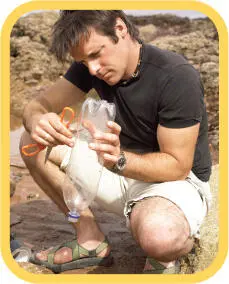
1 Take the bottle and cut off the top about 10cm down (you might need to ask an adult to help you as this can be difficult). You will be left with a funnel and a trap box. Then make lots of small holes in the main part of the bottle.

2 Put some bait into the trap and insert the top of the bottle, neck end down. Fasten in place with strips of gaffer tape.
Читать дальше





















